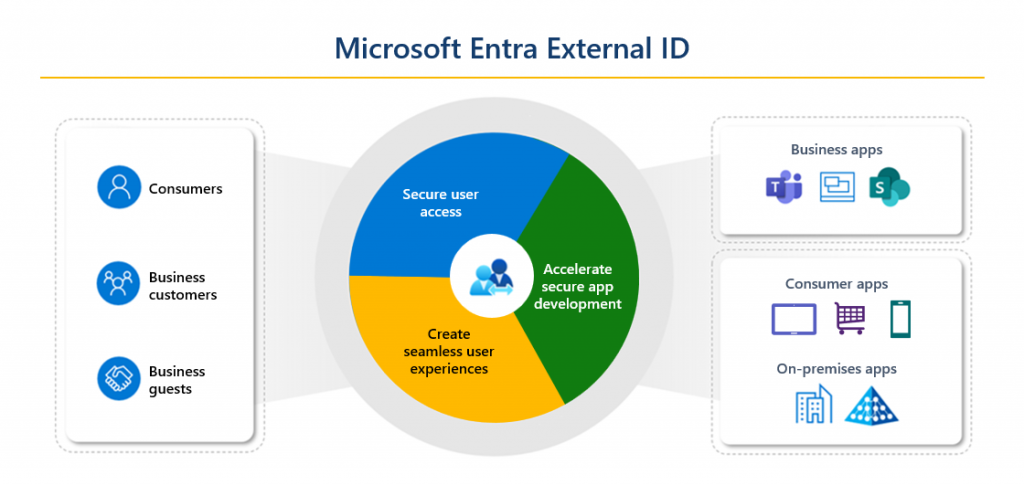Understanding Entra External ID and Azure AD B2C: A Comparative Analysis

In the rapidly evolving landscape of digital identity management, two of Microsoft’s key offerings—Entra External ID and Azure Active Directory Business to Consumer (Azure AD B2C)—stand out as powerful tools. While both services aim to streamline identity management, they cater to different use cases and offer distinct features. This blog post delves into the differences between Entra External ID and Azure AD B2C, helping organizations make informed decisions about which service best suits their needs.

Overview of Entra External ID
Entra External ID is a robust identity management service designed to facilitate secure and seamless access for external users. It is particularly useful for organizations that need to collaborate with partners, suppliers, or customers without compromising security. Key features include:
- Unified Access Management: Entra External ID provides a centralized platform to manage access for external users, ensuring consistent security policies and governance.
- Seamless Collaboration: It allows for smooth collaboration across organizational boundaries, making it easy for external users to access necessary resources.
- Enhanced Security: With advanced security features such as multi-factor authentication (MFA) and conditional access policies, Entra External ID ensures that external access is both secure and compliant.
Overview of Azure AD B2C
Azure AD B2C is designed to manage identity and access for consumer-facing applications. It enables organizations to provide authentication and authorization services to their customers through various identity providers. Key features include:
- Customer Identity Management: Azure AD B2C specializes in handling large volumes of consumer identities, offering a scalable solution for applications with millions of users.
- Customizable User Experience: It allows organizations to customize the sign-in and sign-up experiences to match their brand, providing a seamless user experience.
- Social and Local Accounts: Azure AD B2C supports a wide range of identity providers, including social accounts (e.g., Facebook, Google) and local accounts with email verification.
Key Differences Between Entra External ID and Azure AD B2C
- Target Audience and Use Case:
- Entra External ID: Primarily focused on enabling secure and efficient collaboration with external users such as partners, vendors, and contractors. It is ideal for B2B scenarios.
- Azure AD B2C: Designed for consumer-facing applications, allowing businesses to manage and authenticate customers. It excels in B2C scenarios.
- Identity Providers:
- Entra External ID: Integrates with various identity providers but is generally more aligned with enterprise-level identity management systems.
- Azure AD B2C: Offers extensive support for social identity providers like Facebook, Google, and Microsoft accounts, in addition to local accounts.
- Customization and Branding:
- Entra External ID: Provides a more standardized experience, with a focus on security and compliance.
- Azure AD B2C: Highly customizable, enabling businesses to tailor the user interface and experience to align with their brand identity.
- Scalability:
- Entra External ID: Scales to support external users for enterprise applications, ensuring robust performance and security.
- Azure AD B2C: Designed to handle massive scale, supporting millions of consumer identities with ease.
- Security Features:
- Entra External ID: Emphasizes enterprise-grade security features, including detailed access controls and compliance capabilities.
- Azure AD B2C: Also provides strong security but is optimized for consumer applications, balancing security with ease of use and user experience.
Choosing the Right Solution
When deciding between Entra External ID and Azure AD B2C, organizations should consider their specific use case and requirements:
- For businesses needing to manage and secure access for external partners and collaborators, Entra External ID is the optimal choice due to its enterprise-centric features and robust security capabilities.
- For companies focusing on consumer applications and requiring extensive customization of the user experience, Azure AD B2C is the better fit, offering flexibility and scalability for managing large volumes of customer identities.
Conclusion
Both Entra External ID and Azure AD B2C are powerful tools in Microsoft’s identity management suite, each catering to different needs. Understanding the distinctions between these services helps organizations leverage the right solution, ensuring secure, efficient, and user-friendly identity management for both external users and consumers. By carefully evaluating their specific requirements, businesses can choose the service that best aligns with their goals and provides the optimal balance of security, usability, and scalability.


